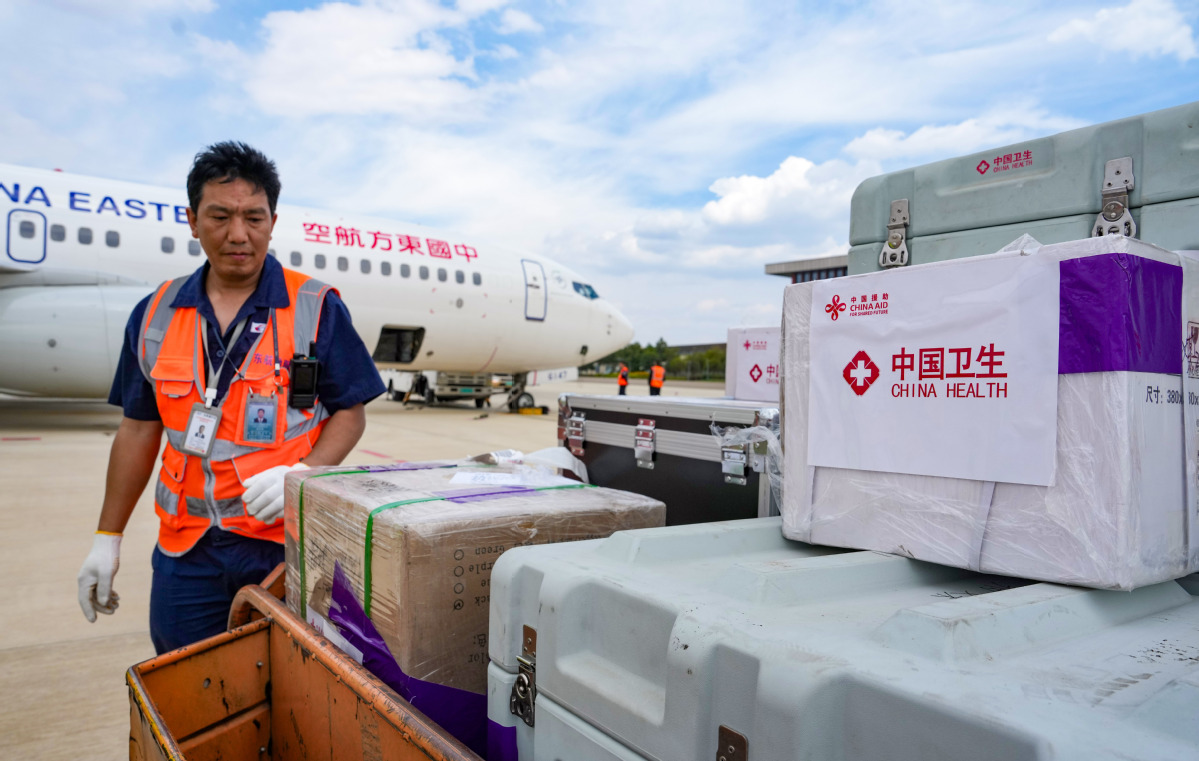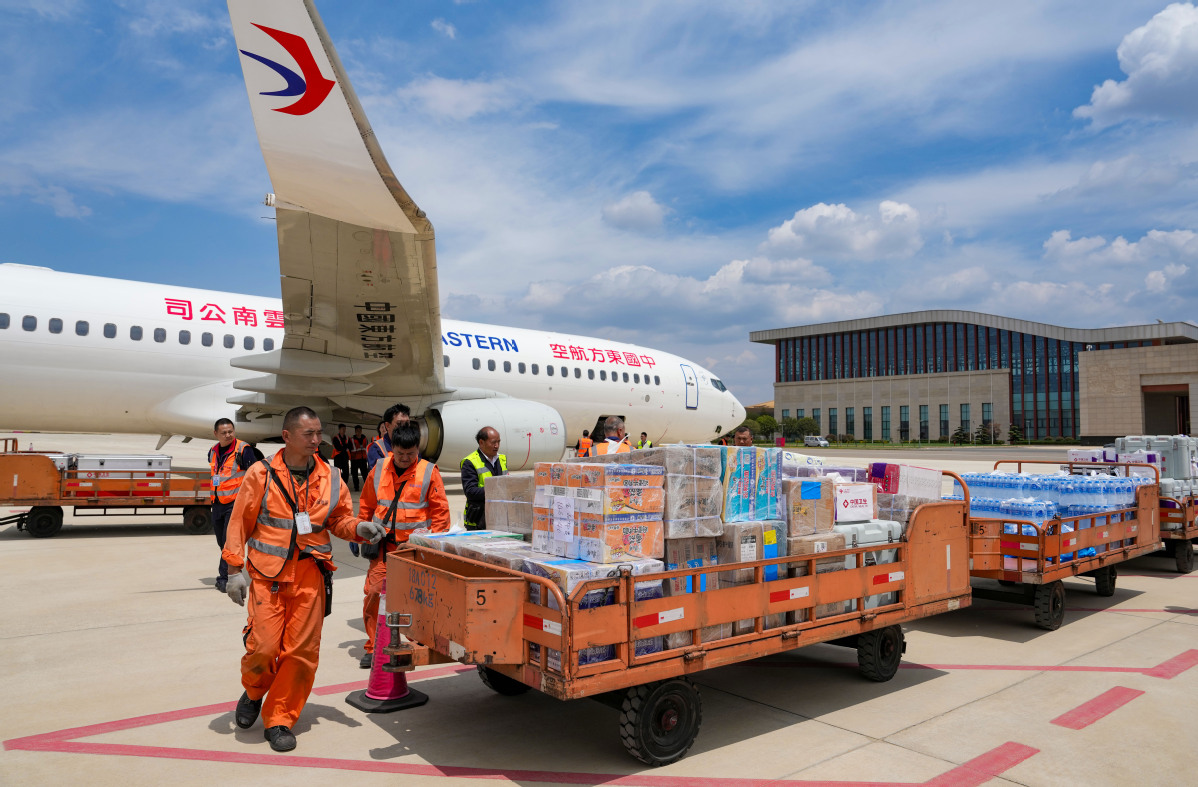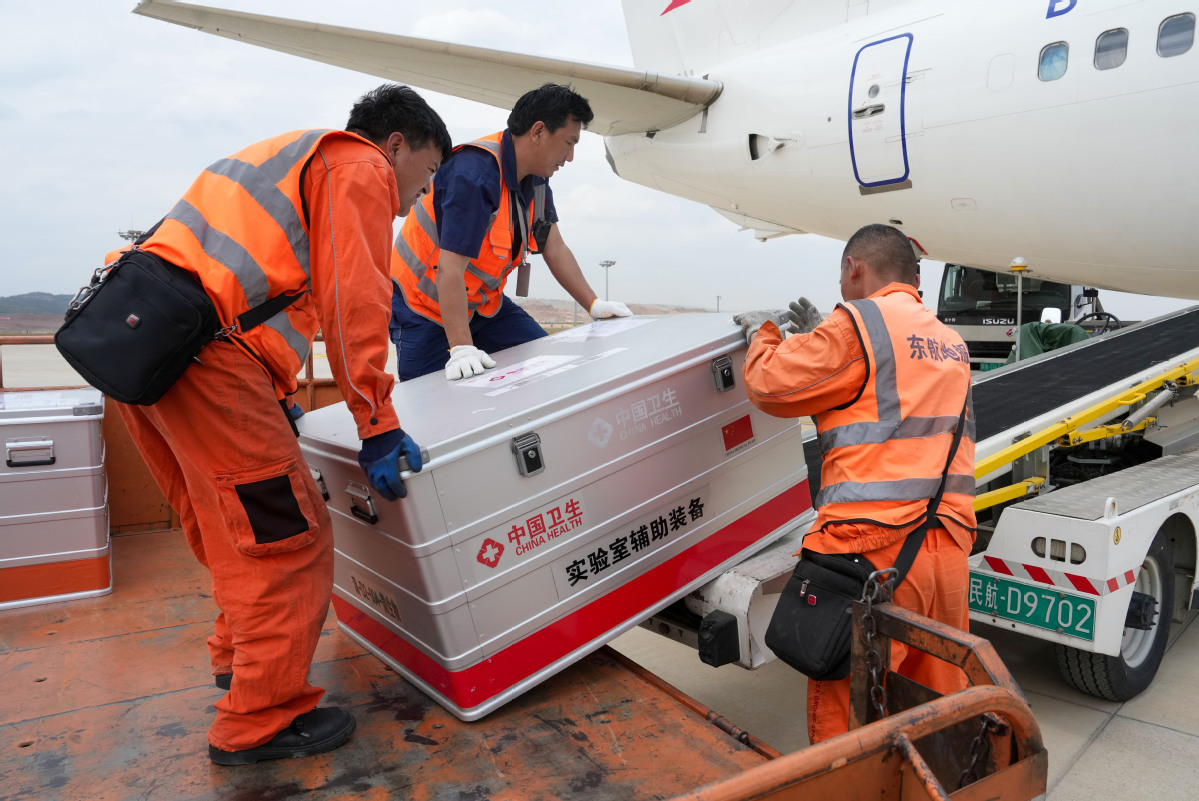

The death toll has risen to 3,798, with 5,106 injured and 106 people reported missing.
Eight Chinese nationals were confirmed dead, 13 injured in the strong earthquake.
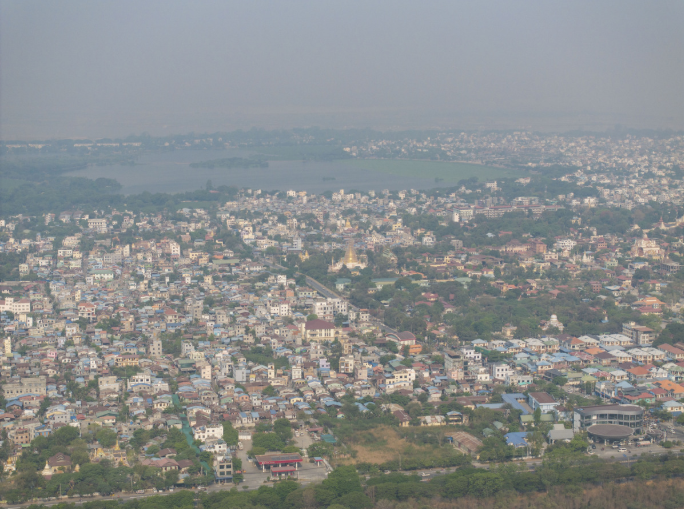
YANGON -- The Office of the Commander-in-Chief of Defense Services of Myanmar on Saturday announced the extension of the temporary ceasefire until June 30, state-owned daily The Mirror reported on Sunday.
The extension, starting June 1, is aimed at supporting rehabilitation and resettlement efforts in quake-affected areas, serving the interests of the country and its people, and promoting peace and stability, the report said.
The Myanmar Armed Forces had earlier declared a temporary ceasefire from May 6 to 31 to help with rescue and relief work after the 7.9-magnitude quake, it added.
During the ceasefire, ethnic armed organizations and other armed groups are urged not to disrupt or attack communication routes used by the public, not to cause harm to or destroy the lives and property of civilians, not to attack security personnel and their camps, not to target military commands, not to recruit or mobilize forces that could undermine peace, and not to expand territories.
If such actions occur, the Myanmar Armed Forces will take necessary response measures to protect the public, the report said.
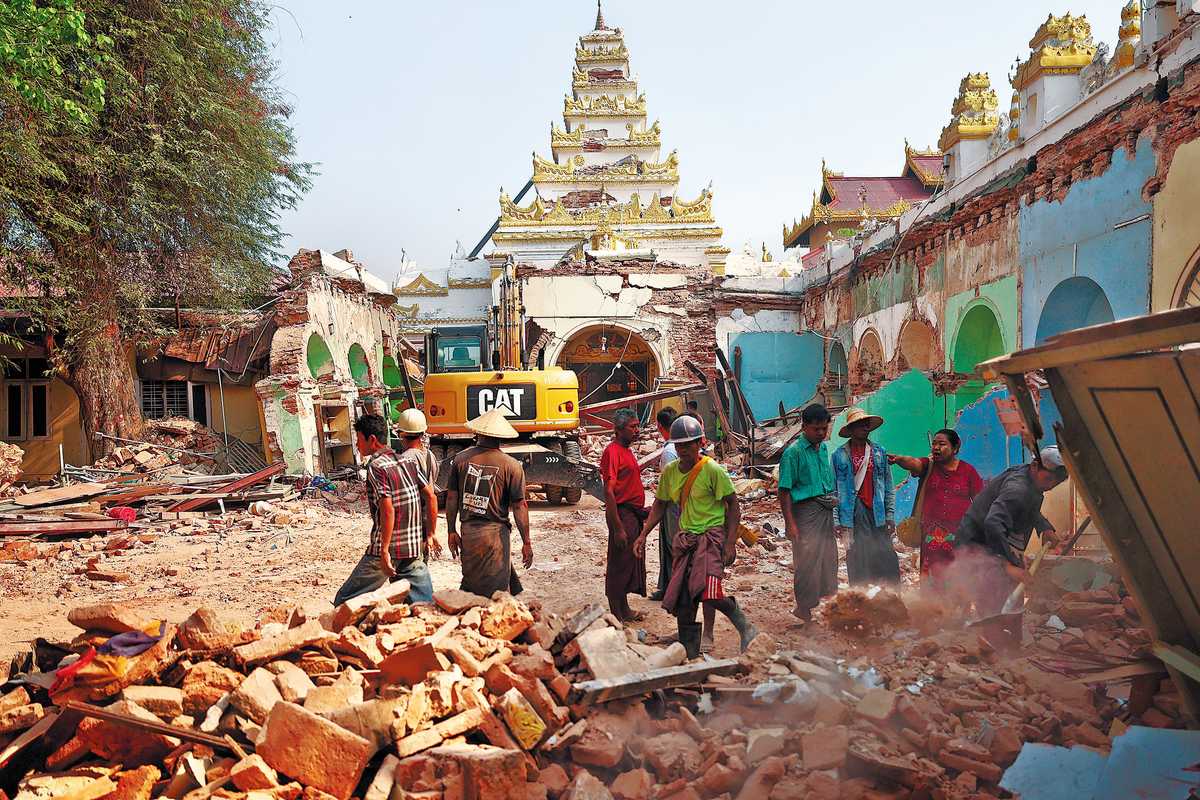
Editor's note: Over one month on after the Myanmar earthquake, this ANN special report examines why it led to so much devastation, the current situation in quake-hit areas, and why earthquake preparedness is crucial.
More than a month after a massive earthquake rattled Myanmar, about 207,000 people, including a large number of women and children, remain displaced, of whom about 42,000 are living in 135 temporary shelters, according to April 22 data from the ASEAN Coordinating Centre for Humanitarian Assistance on Disaster Management, or AHA Centre.
The earthquake was so devastating that it necessitated rebuilding and relocation plans in Myanmar's capital Naypyidaw, Thailand-based online newspaper The Nation reported.
The capital's urban layout is now under review, the article continued, with Myanmar's leader Min Aung Hlaing announcing plans to redesign the city's urban structure during a cabinet meeting held shortly after the quake.
To grasp the massive, destructive scale of the recent earthquake, one must understand the many factors that contributed to it, said Md Sakawat Hossain, professor at the Department of Geological Sciences at Jahangirnagar University, Dhaka.
"A 7.7-magnitude earthquake is quite major by itself. Paired with the shallow depth of the origin (about 10 kilometers) and proximity to major cities Naypyidaw and Mandalay, it has caused intense destruction we see today.
"For context, the amount of energy released during this earthquake was about 330 times that of the Hiroshima bombing."
The resulting conditions are nothing short of catastrophic. Food is difficult to come by and hygiene is a massive concern given the lack of access to reliable sources of clean water for drinking and washing.
The temporary tents, per AHA Centre, are constructed from materials that cannot withstand severe weather, such as heavy rain and extreme heat.
In the wake of the earthquake, the ASEAN said it strengthened the relief and recovery efforts through the ASEAN standby arrangements and ASEAN member states' contributions, among other mechanisms.
Individual countries, neighboring and from farther afield, have also stepped up to give aid, be it through the deployment of rescue workers, paramedics, and even sniffer dogs — some of whom doubled as therapy dogs for survivors and their families, as reported by The Nation.
Reuters published a list of initial aid contributors days after the quake, March 30, which included China, India, the United States, Vietnam, South Korea, Thailand, Russia, Japan, Singapore, Malaysia, Indonesia, the United Kingdom, New Zealand, and the Philippines.
The situation has been so dire that even neighboring nations with complex relations with Myanmar have taken it upon themselves to send in relief and humanitarian aid. Multiple rounds of relief, along with a humanitarian mission, were initiated by Bangladeshi authorities.
According to Bangladesh-based newspaper The Daily Star, two transport aircraft had been sent with 16.5 tons of emergency relief, including dry rations, clean water, oral saline, tents, hygiene products and other essential products to Yangon on March 3.
In a more recent report on Reuters, however, the International Federation of Red Cross and Red Crescent Societies, or IFRC, said on April 17 it had received "only a fraction of an emergency appeal for 100 million Swiss francs ($119 million)" to help in the recovery efforts.
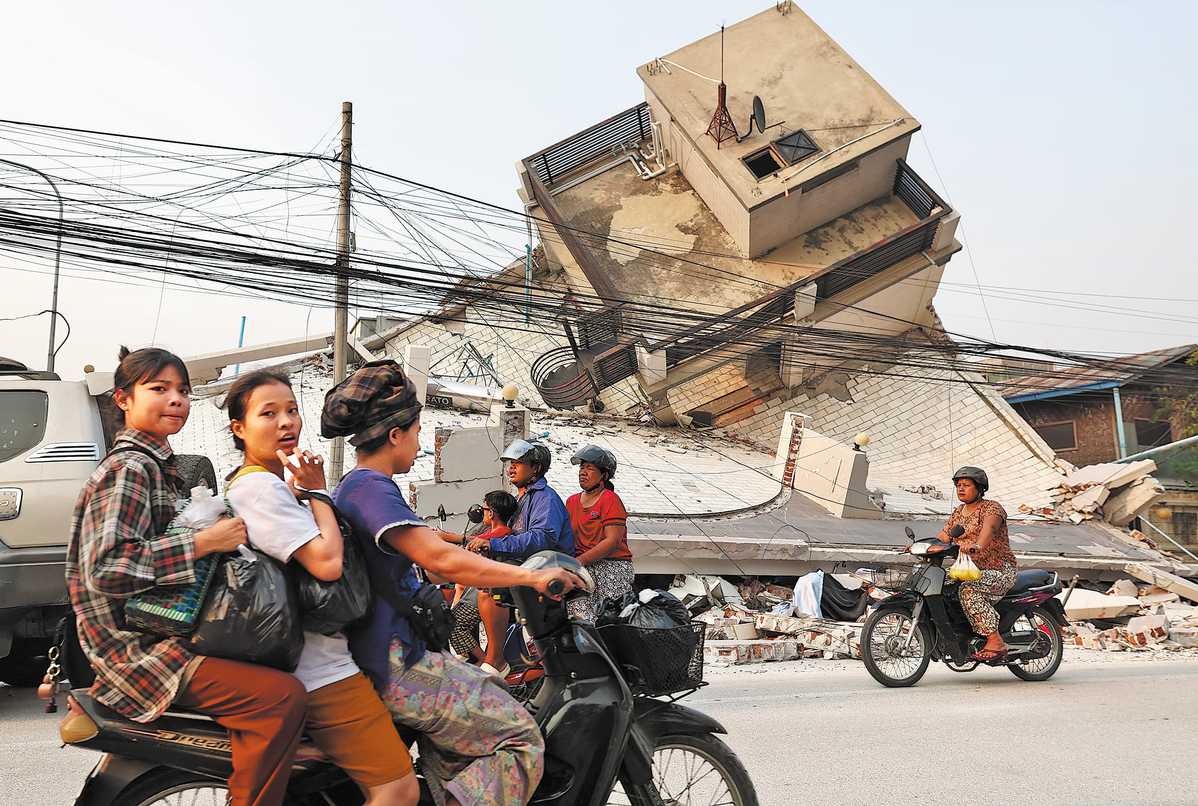
Call for support
The amount is "a lot less than expected", Alexander Matheou from the IFRC tells Reuters via video link in Mandalay.
According to a report released by the United Nations on its website on April 18, 4.3 million people urgently need clean water and sanitation.
Malnutrition is a growing concern, particularly among children as food insecurity worsens. Education infrastructure and farmlands have also been hit hard. On top of this, the report adds, women and children have become more vulnerable.
Mariko Hall, external relations officer of the United Nations High Commissioner for Refugees, or UNHCR, told ANN that 17.2 million people were affected by the earthquake. It also reduced homes, hospitals, and schools to rubble, she added, disrupting markets and essential services, including water and sanitation.
For earthquake-affected communities, Hall said the most urgent needs include emergency shelter, core relief items such as solar lamps, tarpaulins, mosquito nets, tents, kitchen sets, and safe drinking water, food, and healthcare.
"Particularly ahead of the monsoon season, with risk of floods and landslides, shelter support is essential so that people have somewhere safe to live," she added.
Given the existing challenges on the ground, compounded by powerful aftershocks and heavy rains, Hall told ANN that to ensure rapid response, they had to reprioritize existing resources and dispatch emergency supplies from Yangon to assist survivors.
Hall said the ability of UNHCR to deliver humanitarian aid and provide protection assistance largely depends on generous donations from individuals and the international community.
"The UNHCR's total funding requirements for Myanmar in 2025 is $88.3 million to assist displaced people and their host communities," she shared, adding that "As of the end of March, less than 20 percent of funding had been secured."
"At this critical time, the people of Myanmar need the support of the international community more than ever."
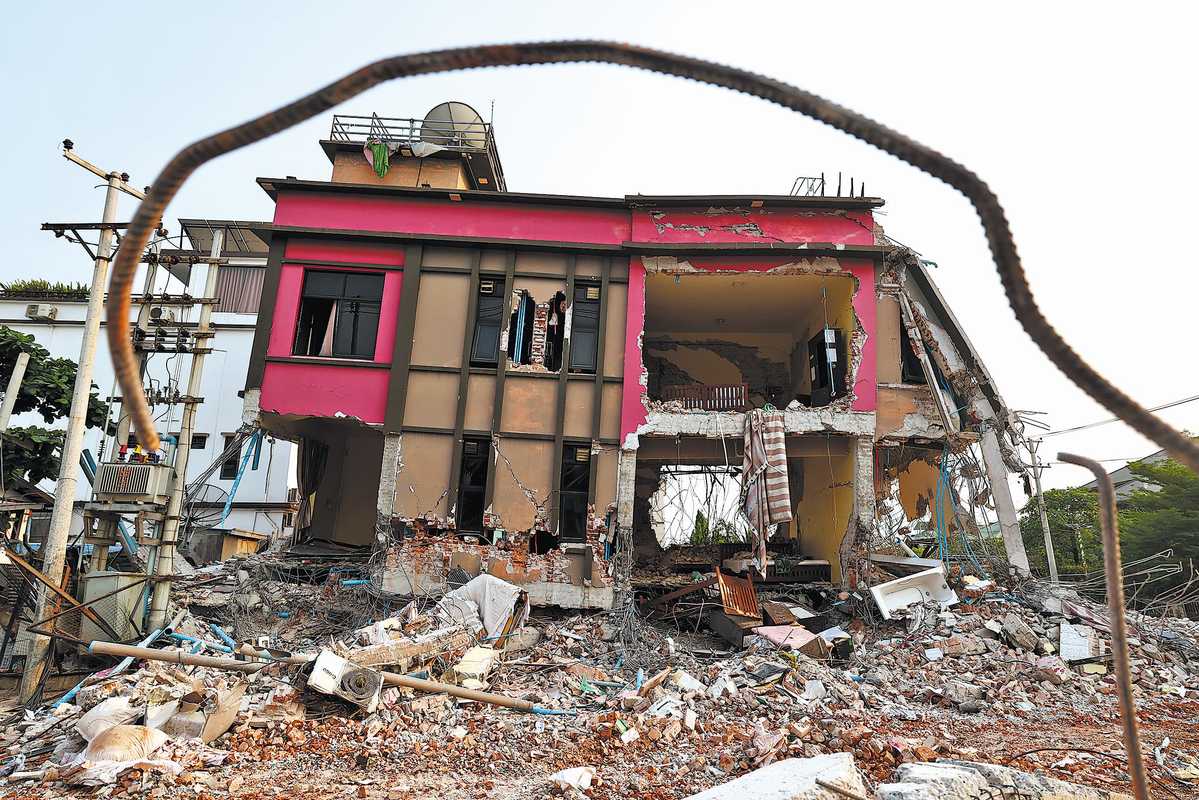
Looming threat
With the sudden onset of such a devastating crisis, there have been speculations about whether this earthquake is an indicator of disasters that may recur in the future within the region.
Misinformation on social media has exacerbated the collective panic among people about the possibilities of earthquakes and the authorities' ability to mitigate the impact of such disasters.
In this regard, Hossain told ANN, "Earthquakes are the only natural disasters that cannot be predicted even a few seconds in advance."
There is no way to warn authorities and the public. This region has many large-scale fault lines, of which many are quite active.
"This includes the Sagaing fault which has experienced about nine major earthquakes in the past 100 years, the Chittagong Coastal fault, the Main Frontal Thrust fault, the Dauki fault, the Oldham fault, the Madhupur fault and the Sylhet fault," he said.
Hossain said most of these faults have recurrence intervals between 20 and 30 years and 200 and 500 years. These faults can impact India, Bangladesh, Nepal, Bhutan, Thailand and Myanmar.
"Thus, I cannot say when or exactly where there can be an earthquake, but I can say there is a looming threat to the region, and we must be prepared," he said.
While analyzing the possible risks of major earthquakes in the region, Hossain mentioned that a lot of major cities in South Asia, such as Mandalay, Naypyidaw, Bangkok, Silchar, Kathmandu, Kolkata, and Dhaka, are built on flatlands and soft sediments.
Earthquakes in flatlands and areas with soft sediment, like delta and basin regions, can result in unique and potentially damaging effects, including liquefaction and ground deformation, which increases the odds of higher damages to the region experiencing the earthquake, including possible subsidence and landslides.
Thus, it is crucial for nations, especially those with densely populated areas and cities, to make necessary arrangements to not only prepare for the possibility of an earthquake and mitigate the possible impacts of such disasters, but also to spread awareness to the public about what can be done and how they can be prepared themselves.
"Authorities must increase their knowledge and vigilance over earthquake hazard assessment capacity, and by investing in equipment and stations that would observe overall seismic activities within the region, giving them the scope to collect as much information as possible.
"Reducing vulnerabilities to power, water, gas and telecom networks is also an extremely important step for authorities, as these infrastructures often take the first hit. Investing in rescue equipment is also a must for each nation in this region," Hossain said while highlighting some of the crucial steps required for managing and preparing for the possibility of major earthquakes.
"Policies and building codes must be updated and strictly implemented to ensure proper construction of earthquake-resistant establishments or infrastructures for all new projects. Authorities must also enforce retrofitting and other engineering measures for older constructions and buildings, allowing impending damage to be minimized," he added.
He further mentioned, "There should be campaigns and training available to make people aware of what to do in case of such an emergency, and make it available in all educational institutes, at all levels and capacities, to better understand what the disaster is and how to keep themselves prepared for it."
Asia News Network
YANGON -- The 14th batch of emergency humanitarian in-kind assistance dispatched by the Chinese government was handed over to Myanmar on Wednesday.
The supplies included 1,804 prefabricated houses and 95 sets of mobile operating rooms, and were received by Yangon Region Chief Minister U Soe Thein.
A 7.9-magnitude earthquake struck Myanmar on March 28. As of May 13, the earthquake has claimed around 3,800 lives and injured over 5,100 people, with 85 others remaining unaccounted for, according to official data.
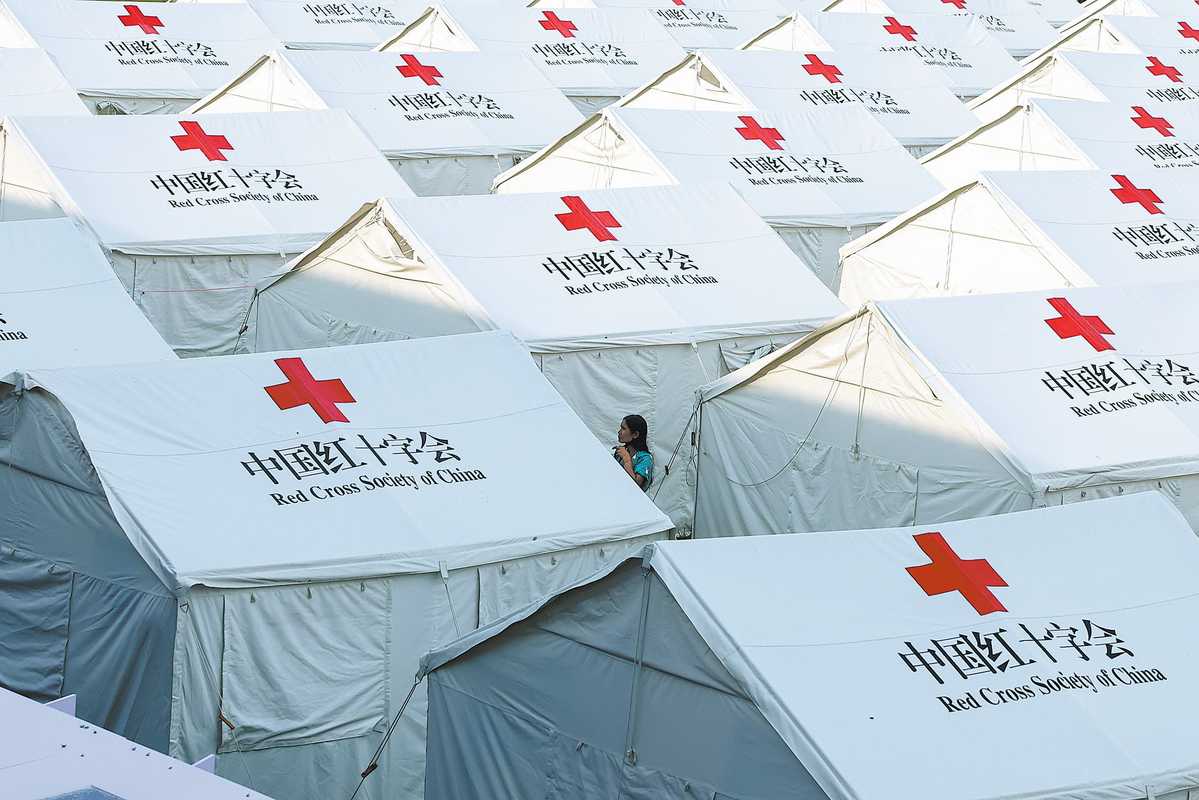
YANGON — Under the white canopy of a China-donated tent at a relief camp in Mandalay, 33-year-old Ma Aye Aye cradled her 9-month-old baby while keeping an eye on a toddler playing nearby.
"These tents protect us from rain, heat, wind, and even mosquitoes if we zip them up," she said, gently holding her baby. "Before this, we lived on the ground."
Ma Aye Aye and her family are among the thousands forced to flee their homes after a series of devastating earthquakes rocked central Myanmar, destroying houses and claiming lives across 10 regions and states. The disaster, which included tremors as strong as magnitude 7.9, left around 3,800 people dead and displaced over 200,000 as of Friday.
"Our house was tilted and cracked," she said. Fearing it might collapse if another earthquake struck, they left, she added.
Like many others, they first took shelter on the roadside before moving to a makeshift camp set up on a football field with China-donated tents. China's donation is part of a larger humanitarian relief effort that brought in 13 batches of food, medicine, prefabricated shelters, fuel, and sanitation supplies.
"Chinese doctors also came. They checked our drinking water and gave health advice for my children," Ma Aye Aye said.
Her husband, a car driver, has struggled to return to work. With roads damaged and daily life disrupted, jobs have been slow to resume, local residents said.
In another part of the camp, 72-year-old Daw Aye Aye Chit shares a China-donated tent with six other family members. "We used to sleep on the street, with nothing above us," she recalled. "Now, we have tents, beds, and lights," she said.
Win Hlaing Phyo, a medical doctor and team leader with Myanmar's Ministry of Health's Central Epidemiological Unit in Mandalay, who is working at a relief camp housing China-donated tents, said the shelters have been a great help.
Xinhua
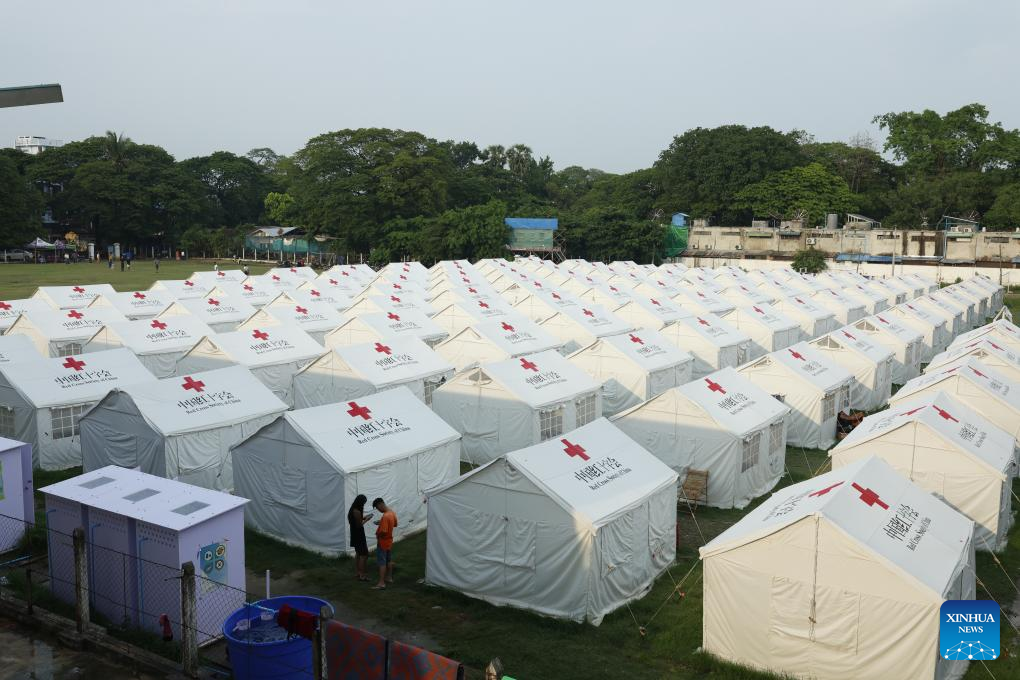
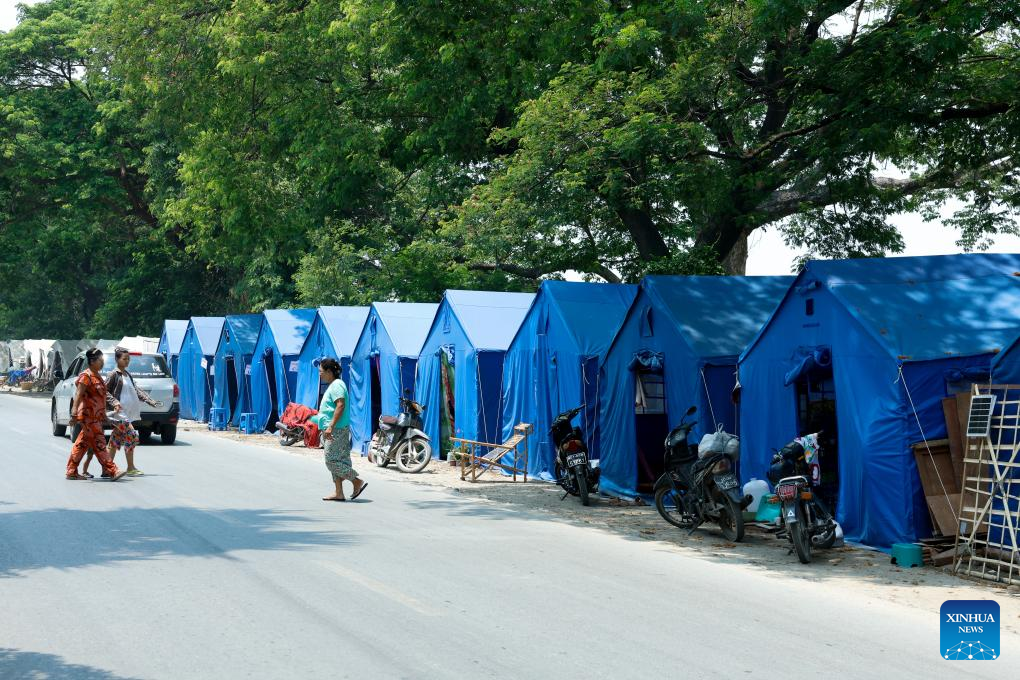
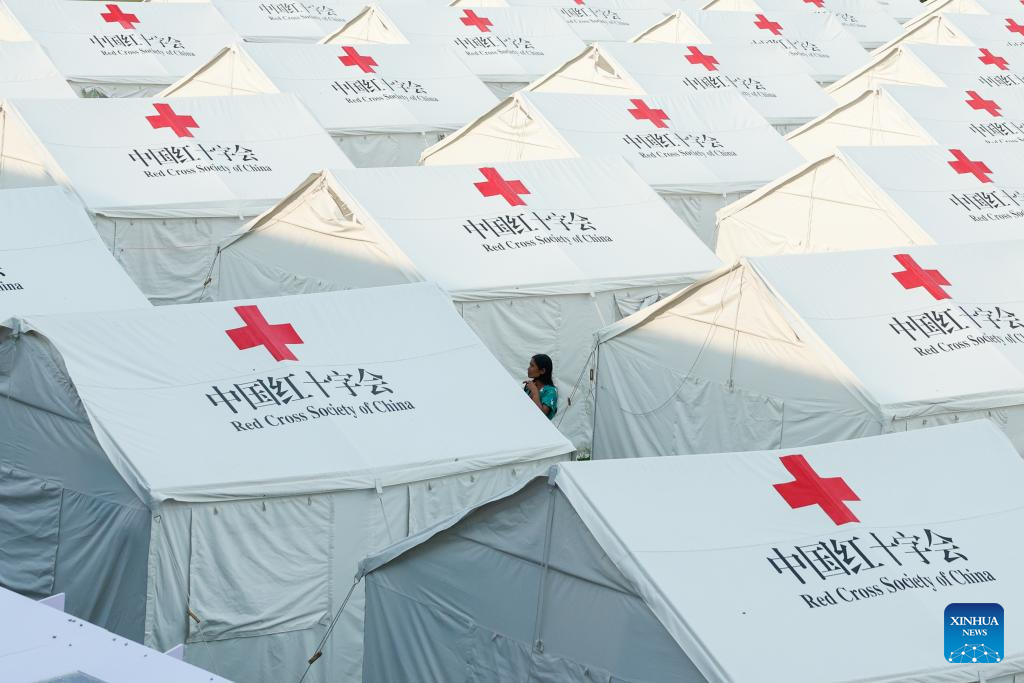
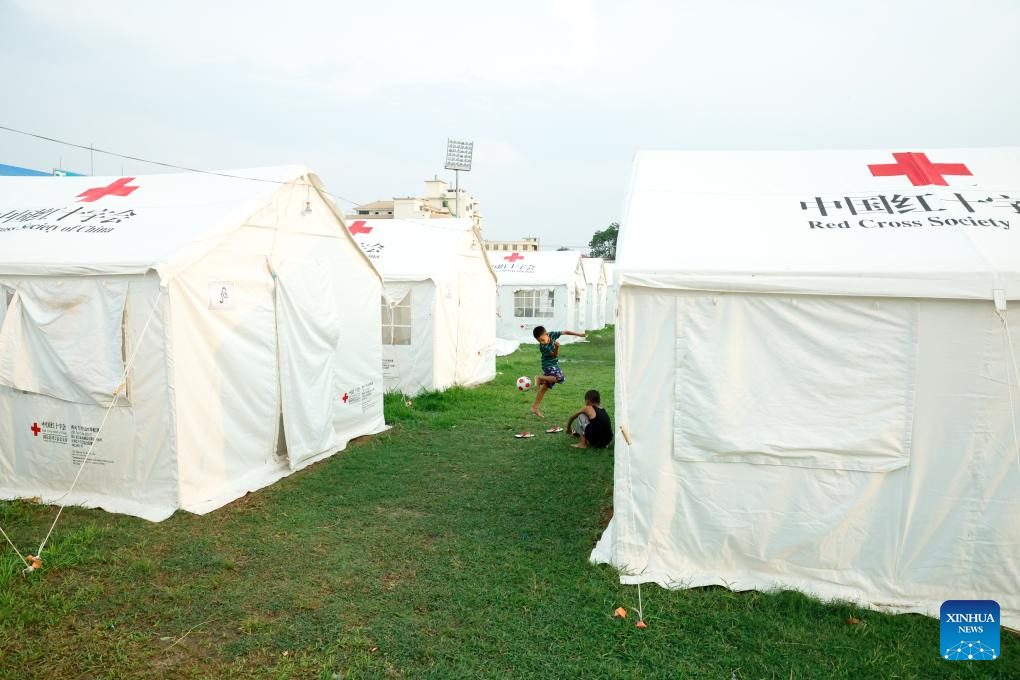
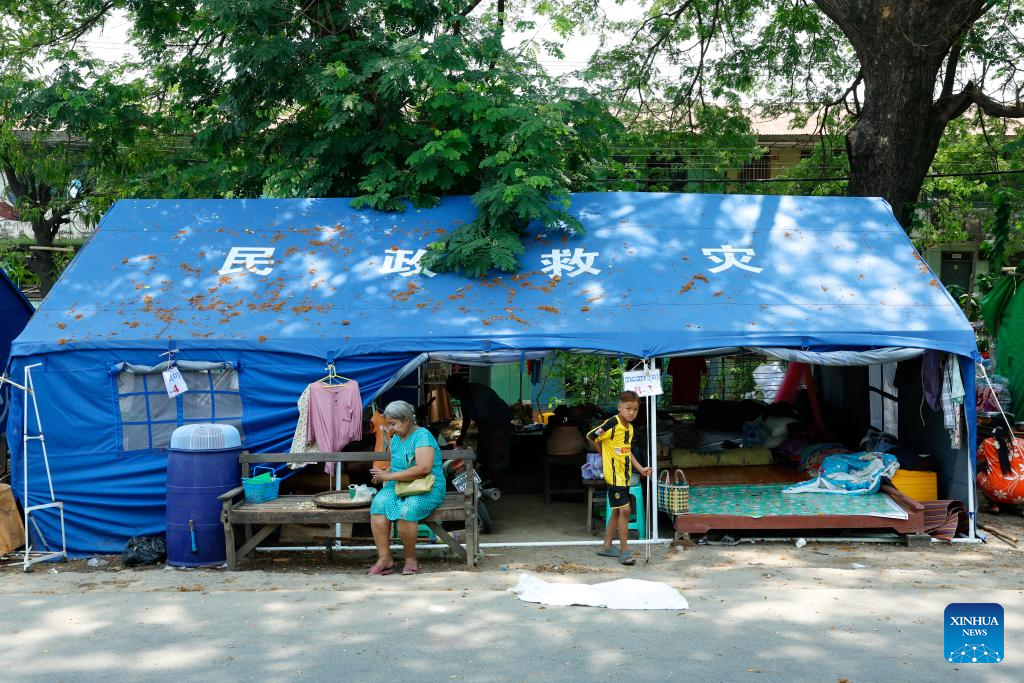
YANGON -- The 12th batch of emergency humanitarian in-kind assistance dispatched by the Chinese government was handed over to Myanmar on Thursday in Yangon, Myanmar.
The aid supplies included 17,000 tons of gasoline, which were accepted by Yangon Region Chief Minister U Soe Thein.
A 7.9-magnitude earthquake struck Myanmar on March 28. As of May 7, the earthquake has claimed around 3,800 lives and injured over 5,100 people, with around 100 others remaining unaccounted for, according to Myanmar's official data.
YANGON -- The eleventh batch of emergency humanitarian aid supplies dispatched by the Chinese government was handed over to Myanmar on Saturday in Yangon, Myanmar.
The aid supplies include 340 prefabricated houses, which were received by Yangon Region Chief Minister U Soe Thein during a handover ceremony.
A 7.9-magnitude earthquake struck Myanmar on March 28. As of May 2, the earthquake has claimed 3,839 lives and injured 5,105 people, with 101 others remaining unaccounted for, according to Myanmar's official data.
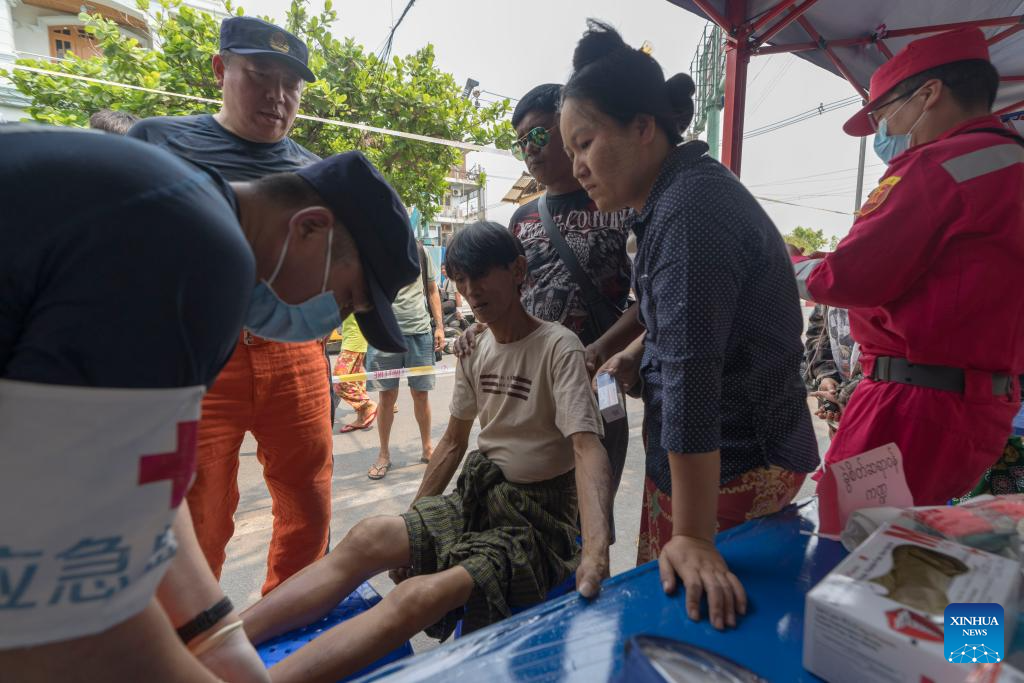
YANGON -- A total of 653 survivors have been rescued by emergency teams following Myanmar's 7.9-magnitude earthquake as of Thursday, the state-owned daily Myanma Alinn reported on Friday.
Both local and international rescue teams carried out search and rescue operations. They were also able to retrieve 779 bodies as of Thursday, the report added.
A 7.9-magnitude earthquake struck Myanmar on March 28. As of May 1, the disaster has claimed 3,835 lives and injured 5,105 people, with 105 others still unaccounted for, official data showed.
YANGON -- The tenth batch of emergency humanitarian aid supplies dispatched by the Chinese government was handed over to Myanmar on Friday in Yangon, Myanmar.
The aid supplies included 18,000 tons of diesel oil. Yangon Region Chief Minister U Soe Thein accepted them in Yangon.
A 7.9-magnitude earthquake struck Myanmar on March 28. As of May 1, the earthquake has claimed 3,835 lives and injured 5,105 people, with 105 others remaining unaccounted for, according to Myanmar's official data.
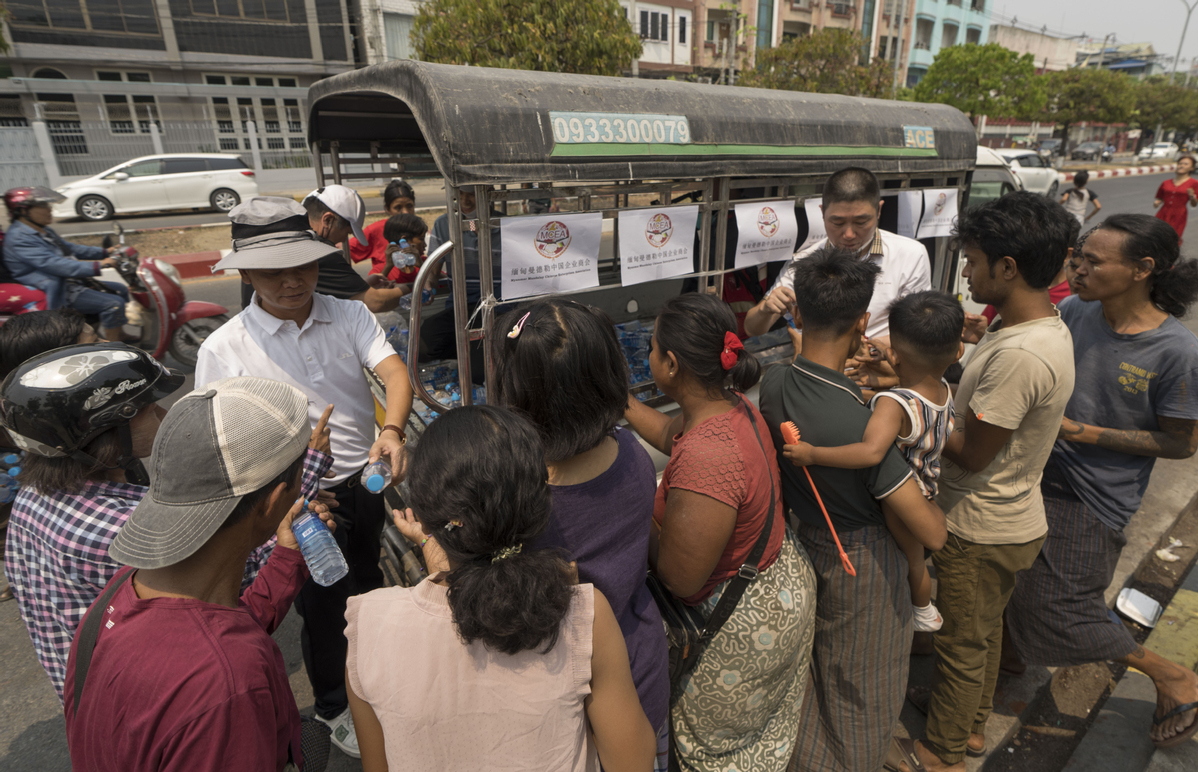
One month after being rocked by a devastating earthquake, millions of people in Myanmar remain in need of more humanitarian assistance from the international community to help with the recovery process that could take months and even years, aid groups said while China's relief efforts were appreciated.
More than 6.3 million people are in urgent need of support, the United Nations humanitarian coordinator for Myanmar, Marcoluigi Corsi, said in a statement on Monday.
Additional and quick disbursement of resources and sustained access to all communities are vital to ensure the situation does not deteriorate further for people already living with severe needs, Corsi said.
"I call on the international community to stand with them — and to support their right to live in safety and dignity," the UN official added.
On March 28, a 7.9-magnitude earthquake struck central Myanmar. The toll stood at 3,770 people killed and over 5,000 people injured as of Monday, the state-owned daily The Mirror reported.
More than 150 aftershocks have taken place since the quake, according to Myanmar's Department of Meteorology and Hydrology.
"Thousands and thousands of families are still living out in the open. They are living in the tents or under tarpaulins that they have put together with wooden poles," said Nadia Khoury, head of delegation of the International Federation of Red Cross and Red Crescent Societies, or IFRC, in Myanmar.
As the cyclone and monsoon seasons will start soon, Khoury told China Daily that the situation will be even more challenging, so more support from the international community is needed.
Khoury said the IFRC has been working with its members, including the Myanmar Red Cross Society, to provide safe drinking water, mobile clinic service, emergency shelter and relief items, as well as specific items to meet the needs of children and women.
Emergency appeal
"We are also very eager to swiftly move for early recovery for those individuals," said Khoury, adding the IFRC had launched a 100 million Swiss Francs ($121 million) emergency appeal.
Khoury praised the quick response by the Red Cross Society of China, or RCSC, which sent a rescue team just one day after the earthquake.
"They have provided very generous support," Khoury said, adding that she expects more cooperation with the RCSC in terms of expertise sharing and distribution of relief items.
Apart from the 100 million yuan ($13.7 million) worth of emergency humanitarian aid announced soon after the earthquake, China also pledged 1 billion yuan in additional aid to Myanmar, with expert teams to be sent for healthcare and reconstruction, according to the Chinese embassy in Myanmar.
Globally, a number of organizations have launched fundraising appeals to support Myanmar. On April 28, the United Nations Population Fund launched a flash appeal for $12 million to provide assistance to nearly 700,000 people, with a focus on essential sexual and reproductive health services.
Noting that the earthquake has exacerbated preexisting vulnerabilities in Myanmar, which is facing severe humanitarian challenges due to domestic conflict, the International Rescue Committee, a nongovernmental organization in New York, said in a statement that more funding is required to deliver life-saving aid, restore essential services, and prevent further loss of life.
YANGON -- The death toll from a 7.9-magnitude earthquake in Myanmar has risen to 3,770 as of April 28, the state-owned daily The Mirror reported on Tuesday.
In addition, 5,106 people were injured and 106 people were reported missing, the report said.
YANGON -- Myanmar has experienced a total of 157 aftershocks following the devastating 7.9-magnitude earthquake on March 28, the country's Department of Meteorology and Hydrology reported on Monday.
The aftershocks ranged from magnitude 2.8 to 7.5, the department said.
As of April 25, the death toll from the earthquake has risen to 3,763, while 5,107 people were injured and 110 people reported missing, the official daily Myanma Alinn reported.

YANGON -- More than 200,000 people have been displaced after a powerful 7.9-magnitude earthquake struck central Myanmar on March 28, the official daily The Mirror reported Saturday, citing the National Disaster Management Committee (NDMC).
At the NDMC's third meeting of the year, held Friday in Nay Pyi Taw, Committee Chairman Vice Senior General Soe Win said the earthquake caused widespread destruction across 10 regions and states, including Nay Pyi Taw, Sagaing, Mandalay, Bago, Magway, and Shan.
He reported that 3,763 people have been killed and 5,107 injured, while 110 remained missing as of Friday. In total, 629,206 people from 128,965 households were directly affected.
As of April 23, 48,656 of the total displaced people have been sheltering in 135 rescue centers, while 159,239 others have relocated independently, according to the report.
Despite being affected, more than 421,000 people have remained in their homes as their houses are still livable, Soe Win said.
Search and rescue operations, along with damage assessments and recovery work, are underway in hard-hit areas like Sagaing, Mandalay, and Nay Pyi Taw, he added.
The earthquake destroyed or damaged over 63,000 homes, 6,700 schools, 5,400 monasteries, 5,300 pagodas, and hundreds of other religious buildings, hospitals, bridges, roads, and dams, he said.
International medical teams, including 337 foreign personnel, have set up temporary hospitals in the worst-affected areas and are providing care alongside local health workers.
Soe Win said the funds donated by local and international donors via the NDMC are being systematically distributed for rescue and recovery efforts.
Following a request for international assistance by the Myanmar government, 2,095 rescue workers from 26 countries and regions have arrived in Myanmar, bringing over 3,800 tons of relief supplies using 147 planes, seven ships, and 23 vehicles, he added.
Authorities are inspecting damaged buildings using a color-coded system -- blue, orange, and red -- to assess structural damage and guide repairs.
Temporary housing, including bashas and modular shelters, is being built for displaced staff and residents, while plans are underway to reconstruct homes using earthquake-resistant designs based on soil testing and fault-line assessments.
Since the earthquake on March 28, Myanmar has experienced over 150 aftershocks, and rescue and recovery operations are ongoing, the report said.
YANGON -- The ninth batch of emergency humanitarian aid supplies dispatched by the Chinese government on Saturday arrived in Yangon, Myanmar, according to a statement released by the Chinese Embassy in Myanmar on Saturday.
The aid supplies included 68,000 doses of tetanus vaccines (adsorbed), 570,000 doses of recombinant B subunit cholera vaccine for adults, and 77,910 doses of recombinant B subunit cholera vaccine for children, the statement said.
A 7.9-magnitude earthquake struck Myanmar on March 28. As of April 26, the earthquake has claimed 3,769 lives and injured 5,106 people, with 107 others remaining unaccounted for, according to Myanmar's official data.

YANGON -- The death toll from a 7.9-magnitude earthquake in Myanmar has risen to 3,763 as of Friday, the official daily Myanma Alinn reported on Saturday.
In addition, 5,107 people were injured and 110 people reported missing, the report said.

At the request of the Myanmar government, China has dispatched a team to assess disaster losses following a 7.9-magnitude earthquake that struck the Southeast Asian country in late March, according to the China Earthquake Administration.
The team, organized by the administration, was sent last Wednesday and is expected to provide scientific support for Myanmar's post-disaster reconstruction and disaster prevention efforts, the agency said in a statement.
Composed of 30 experts from universities and research institutions across China, the team has completed disaster investigations and assessments in Yangon, Bago and Nay Pyi Taw. The experts evaluated the earthquake's intensity and scope in these areas and offered recommendations for emergency response and repair of damaged homes.
On Tuesday, the team moved to Mandalay to continue its work.
According to the administration, this is the first professional assessment team sent by the Chinese government to the quake-hit region in Myanmar after local efforts transitioned from emergency rescue to epidemic prevention and recovery.
YANGON -- As of Tuesday, 52 people have been rescued, and 103 bodies have been recovered from the collapsed Sky Villa condo in central Myanmar's Mandalay region, the state-run Global New Light of Myanmar reported on Wednesday.
The building collapsed after a powerful earthquake struck on March 28, the report said.
The Myanmar Rescue Team, Mandalay Region Fire Services Department, and the Mandalay Region government personnel have been carrying out rescue and clearance operations since March 28 at the collapsed site of Sky Villa, it added.
The earthquake has caused the deaths of 3,759 people and injuries to 5,107 others, with 114 individuals still reported missing nationwide as of Tuesday, according to Global New Light of Myanmar.

Fifty Chinese health workers departed on Saturday from Kunming, Yunnan province, to assist Myanmar with its epidemic prevention efforts following a magnitude 7.9 earthquake that devastated the country in late March.
The team's deployment is part of China's ongoing post-disaster relief mission. Its trip marks China's second health and epidemic prevention aid mission to Myanmar. The first team returned on April 6 after a nine-day deployment.
According to Chen Lei, deputy director of the emergency response department of the National Disease Control and Prevention Administration and leader of the team, the earthquake caused severe damage to public health infrastructure. Combined with extreme heat and heavy rainfall, the region is now facing a complex and critical epidemic situation involving diseases such as cholera, measles, dengue fever and malaria.
The team will be stationed in Mandalay, one of the hardest-hit areas, and will assist with infectious disease control, risk assessment, disease surveillance, laboratory testing, epidemiological investigations, environmental disinfection, vector control, drinking water hygiene testing, health education and technical training.
The earthquake, which struck on March 28, killed 3,726 people and injured 5,105, with 129 others still unaccounted for as of April 18, according to the information team of Myanmar's State Administration Council.
He Jibo, 47, from the Yunnan Center for Disease Control and Prevention, was a member of the first team. He recalled the hardships they endured, including extreme heat, limited access to food and water, fear of aftershocks and swarms of mosquitoes, but also noted the warmth of local residents and the strength of the China-Myanmar friendship forged through adversity.
He and four other colleagues were tasked with testing water quality at a hospital in Nay Pyi Daw, Myanmar's capital, where many of the earthquake's victims were being treated. With much of the hospital's infrastructure destroyed, patients were housed in tents in the parking lot.
The team tested water for eight indicators, including residual chlorine, total chlorine, pH and hexavalent chromium.
"We exchanged two big bottles of water for the specimen we tested. They were very moved," He said. "One local worker showed me they only had a small bag of dried food for the whole day, and said they didn't have medicine. We immediately donated six bottles of water. He was very happy."
Temperatures soared to 40 C, and mosquitoes were everywhere, making prevention of vector-borne diseases such as dengue fever and malaria a top priority.
The Chinese team conducted health surveys, distributed mosquito insecticide and manual sprayers, and provided disinfectants that helped alleviate a severe local shortage. Other focuses included heatstroke prevention and waste disposal.
The health workers had little time to prepare.
"We took our luggage and left just hours after the earthquake, without saying goodbye to our families," He said.
Since 2018, the team has undergone monthly training that includes trekking 5 to 8 kilometers with 23- to 28-kilogram backpacks, simulating conditions they may face in the field. They are trained in water testing, disinfection, camp building and emergency survival skills.
Zheng Erda, another team member, said that training proved invaluable.
"I used to think the backpack was too heavy, but now every time I go out, I want to bring 10 more bottles of water," Zheng said.
Zhao Xiaonan, 39, agreed, saying the training helped them endure extreme conditions.
"It felt like the whole Earth was burning," he said.
To ward off mosquitoes, they dripped medicated oil into their face masks. Communication was difficult, and the first two nights were sleepless. Their initial shelter was a damaged building with barely any ceiling.
"We wore helmets indoors, installed warning devices and mapped out an escape route," Zhao said. "What was funny was that just after we arrived, an aftershock hit and we all ran out."
He Jibo said he was touched by the support of local volunteers, who provided fruit, phone cards, slippers and towels, and helped interpret and make local contacts.
Zheng said the experience underscored the importance of their work. "I feel a strong sense of accomplishment."
U Than Htike, vice-president of the Myanmar-China Friendship Association in Mandalay, praised China's timely support.
"When major disasters strike, China always stands in solidarity with us and offers swift assistance," he said. "Epidemic prevention experts worked tirelessly on the front lines. We are truly grateful."
Yunnan has a long history of cooperation with Myanmar in public health, including donations of vaccines and medicines, training of local medical staff, and the establishment of testing labs and joint epidemic monitoring stations, according to the Yunnan Center for Disease Control and Prevention.
Xinhua contributed to this story.
Contact the writers at chenmeiling@chinadaily.com.cn
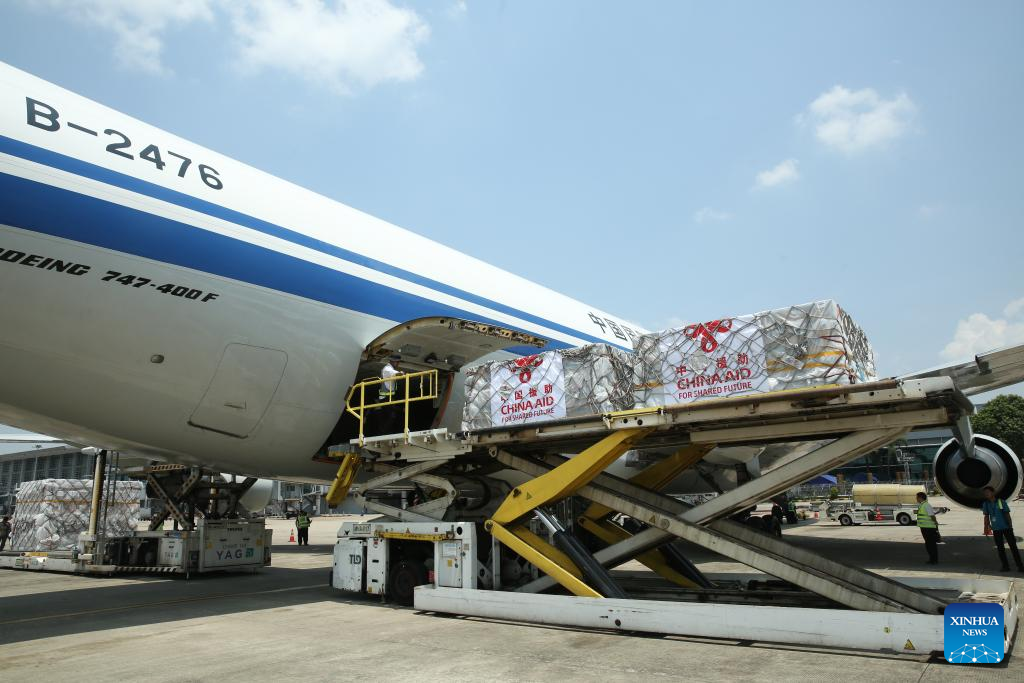
YANGON -- The seventh batch of emergency humanitarian aid supplies dispatched by the Chinese government on Sunday arrived at Yangon International Airport, Myanmar, which was hit by a devastating 7.9-magnitude earthquake on March 28.
The aid supplies include 800,000 boxes of amoxicillin capsules, 122,000 bottles of paracetamol and mannitol injection, 225,000 boxes of cefradine capsules, and 480,000 bottles of ibuprofen tablets, with a total weight of 95 tons.
The earthquake has claimed 3,726 lives and injuring 5,105 people, with 129 others remaining unaccounted for as of April 18, according to Myanmar's official data.
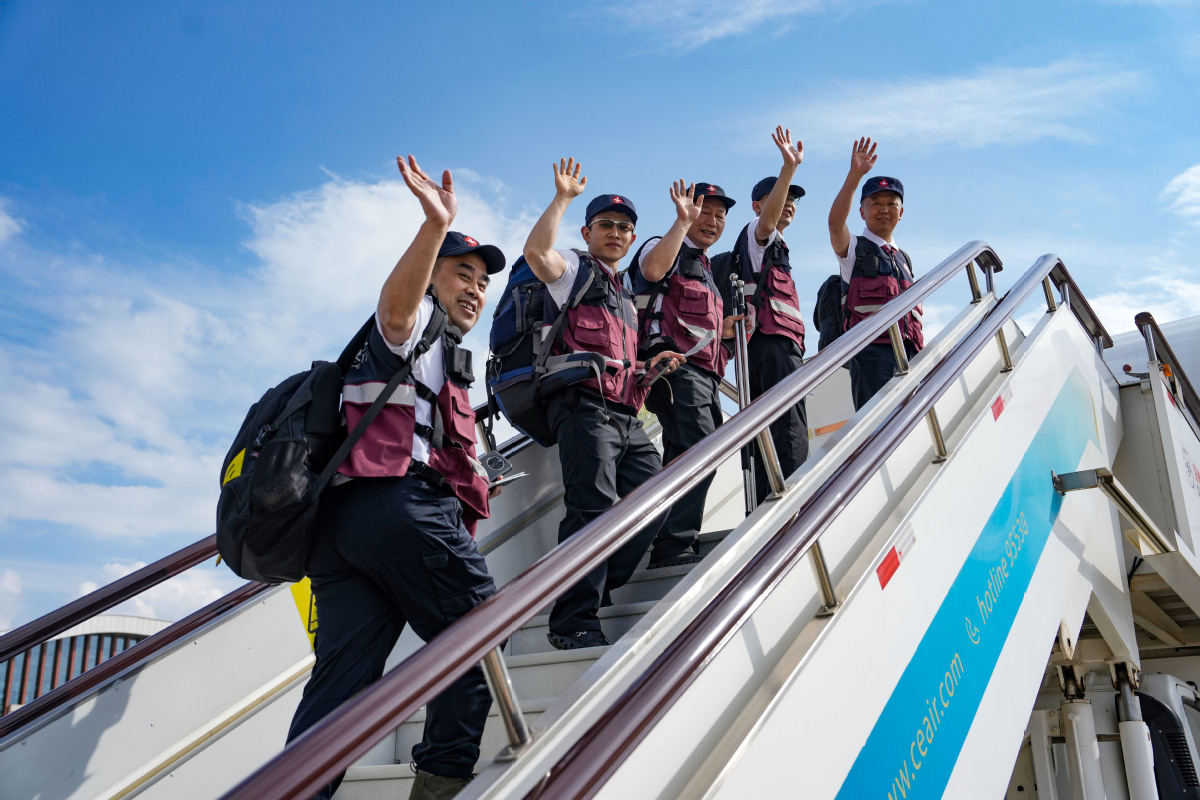
KUNMING -- A Chinese health team consisting of 50 members departed for Myanmar on Saturday to assist with post-disaster epidemic prevention following a 7.9-magnitude earthquake that struck the country in March.
The team, assembled at Myanmar's request as part of China's expanded humanitarian aid announced on April 10, includes 12 members from Beijing and 38 medical experts from Kunming, capital city of Southwest China's Yunnan province.
Equipped with emergency medical supplies and equipment, the team will focus on mitigating disease risks in quake-affected regions.
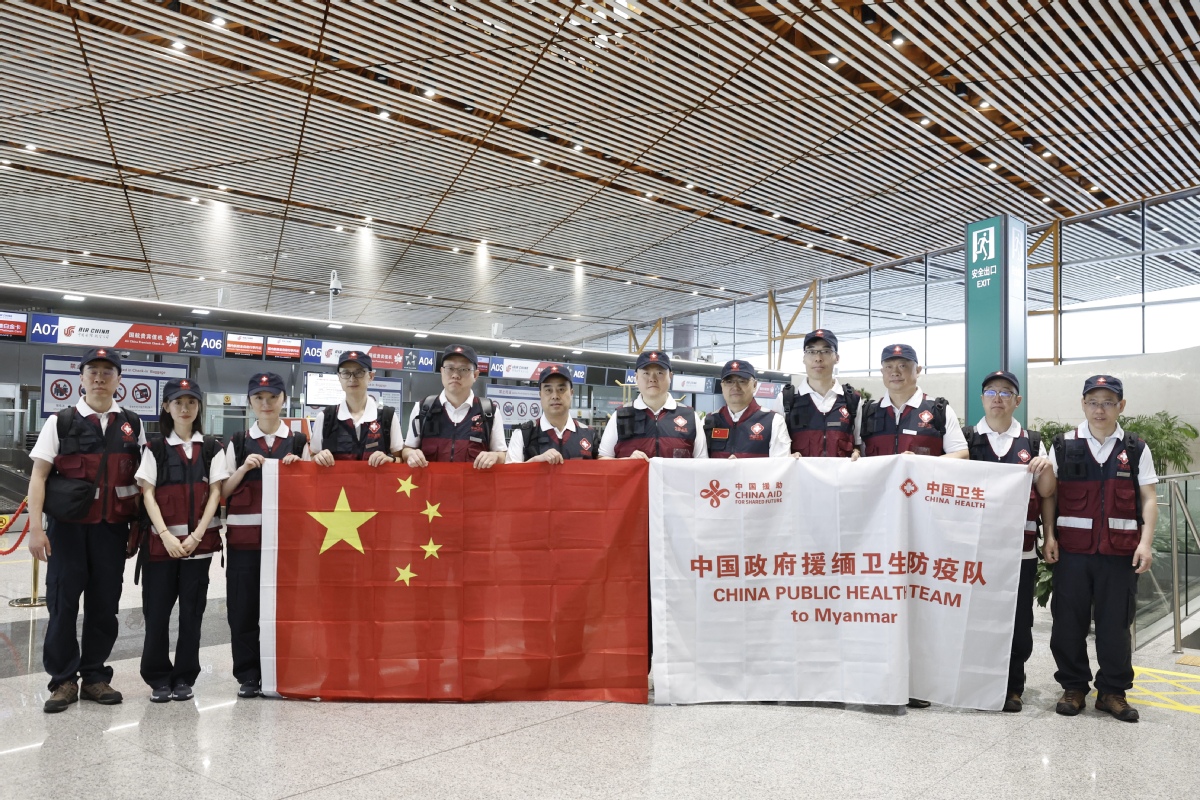
The team will work primarily in Mandalay, one of the hardest-hit regions, to implement disease prevention and control measures. Tasks will include infectious disease risk assessment, epidemiological surveillance, laboratory testing, environmental disinfection, vector control, drinking water safety inspection, public health education, and technical training for local personnel.
The team includes experts from the National Disease Control and Prevention Administration (NDCPA) and the Chinese Center for Disease Control and Prevention.
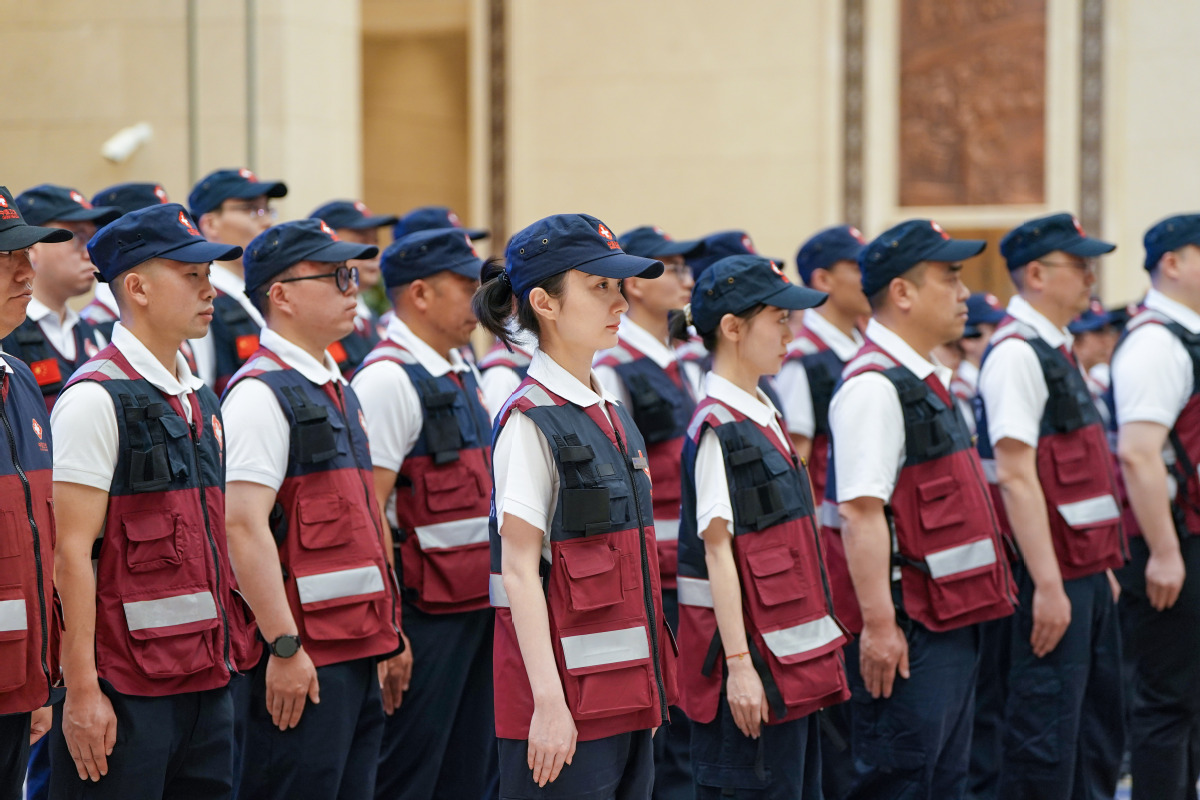
Chen Lei, deputy director of the NDCPA's emergency response department and leader of the mission, said that the earthquake has severely damaged public health infrastructure, and that extreme heat and torrential rains have exacerbated outbreaks of cholera, measles, dengue fever and malaria.
The earthquake jolted Myanmar on March 28, claiming 3,726 lives and injuring 5,105 people, with 129 others remaining unaccounted for as of April 18, according to official data on Saturday.
